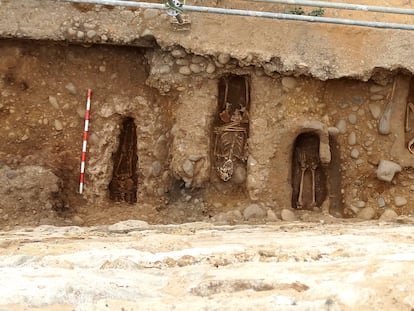The 27,000-year-old cave art found under graffiti in Spain’s Basque Country
Researchers say the bison painting, carved in a style previously unseen in the Iberian peninsula, indicates the existence of a shared artistic culture in ancient Europe
Diego Garate, doctor of prehistory at the University of Cantabria and a specialist in Paleolithic art, was surprised when he came across a 27,000-year-old painting of a bison a meter and a half long, hidden under graffiti, in one of the Aizpitarte caves in the Basque Country. The discovery of the artwork, obscured by the word “exit” and an arrow indicating the way out of the cave, took place in September 2015. Now, following years of research, investigators claim it indicates the existence of a shared artistic culture in ancient Europe.
According to Garate, the bison painting was found when he and a team of speleologists explored the cave in search of cave art. “We went through a small, very low arch about 50 centimeters high, that led into a passageway and when I raised my head I saw an impressive bison covered by graffiti on the rock,” he says. “Its characteristics were similar to those of other bison found in at least 17 caves in different parts of the Iberian Peninsula and Central Europe.” Garate and his team’s research, which was published last week in the journal PLOS One, also includes studies of paintings found in three caves in the area of bison, horses and a bird in an artistic style previously unseen in the Iberian peninsula.
Garate began searching for Paleolithic paintings in Spain’s Basque Country a decade ago. “Very little was known about the cave art in this region compared with neighboring areas such as Cantabria, which has the Altamira cave; or the central Pyrenees, which is full of decorated caves; or the French Dordogne, which is famous for its paintings of bison and mammoths,” says Garate.
In the center of that geographical triangle is Basque Country, which then – like now – was a transit area for people crossing between the Iberian Peninsula and the rest of Europe. “It was paradoxical that there was so little cave art considering it was the only pass available to the men and women of that period,” says Garate. In 2011, when he began his research, only six caves with artwork were recorded in the entire Basque Country. Now that number has risen to 28.
Manuel González Morales, a researcher at the International Institute of Prehistoric Research in Cantabria, says that Garate’s work is “extraordinarily” significant both archaeologically and historically as it has revealed more locations containing Paleolithic art in an area that, until several years ago, appeared relatively empty of this kind of historical evidence. Beyond purely aesthetic considerations, González says these paintings represent “new examples of how underground spaces, including some difficult to access, were used for the development of artistic activity.”
Garate claims that the discovery of the bison paintings in that region of Spain proves that its inhabitants exchanged ideas, shared graphic expressions and had similar and recurring motifs. “We have discovered that human groups in the area communicated with each other,” says Garate. “For example, they used the same tools fashioned from bone to sculpt the stone. We found the remains of those tools in the same caves where we found the paintings.”
The research also points to the existence of exchange networks rather than the same groups of humans moving or migrating from one place to another. “These bison are proof of what would be the first instance of globalization on a continental scale, from Central Europe to the Iberian Peninsula, something like the first European Union 27,000 years ago,” says González, who adds that Garate’s findings show that Upper Paleolithic hunter-gatherer groups made contact with other groups and exchanged technical and stylistic ideas.
One of the most notable features of these paintings is their perspective, which is very different from what we use today. “The type of art that was developed on the continent 27,000 years ago was expressionist,” explains Garate. “The artists did not try to depict reality, but to offer their own interpretation of it.” Consequently, the animals in these paintings appear disproportionate – their faces are grotesque while their legs and horns are two dimensional, like the art found in Egyptian temples.
Garate explains that the style of the paintings is difficult to appreciate today, not because the artists could not portray the subject of their art as they saw them, but because there was an established painting technique. “It gives us the feeling that the art was controlled; subject to rules imposed from a place of power,” says Garate. “The artist would be more like a craftsman. Rather than doing what occurred to them, they could only do what they were ordered to do. It was a collective rather than an individual form of art.”
But experts still don’t know the purpose or meaning of these paintings. “There are multiple interpretations and perhaps there is more than one answer,” Garate acknowledges. “We know that for 30,000 years, animals rather than plants, humans or stars were depicted. Over that period of time, there were several different human groups, but the art is limited to the same motif. We also know that they [the paintings] did not depict the animals that were hunted and eaten, which makes us think that these paintings have a very strong message, perhaps related to social cohesion; to that need to keep the group together in order to survive.”
English version by Heather Galloway.










































